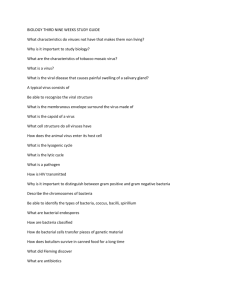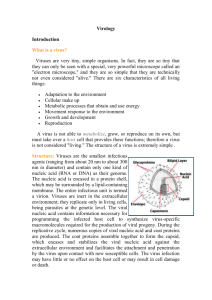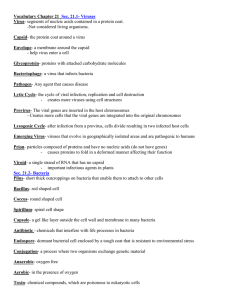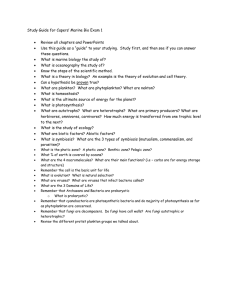Virology Introduction What is a virus?
advertisement
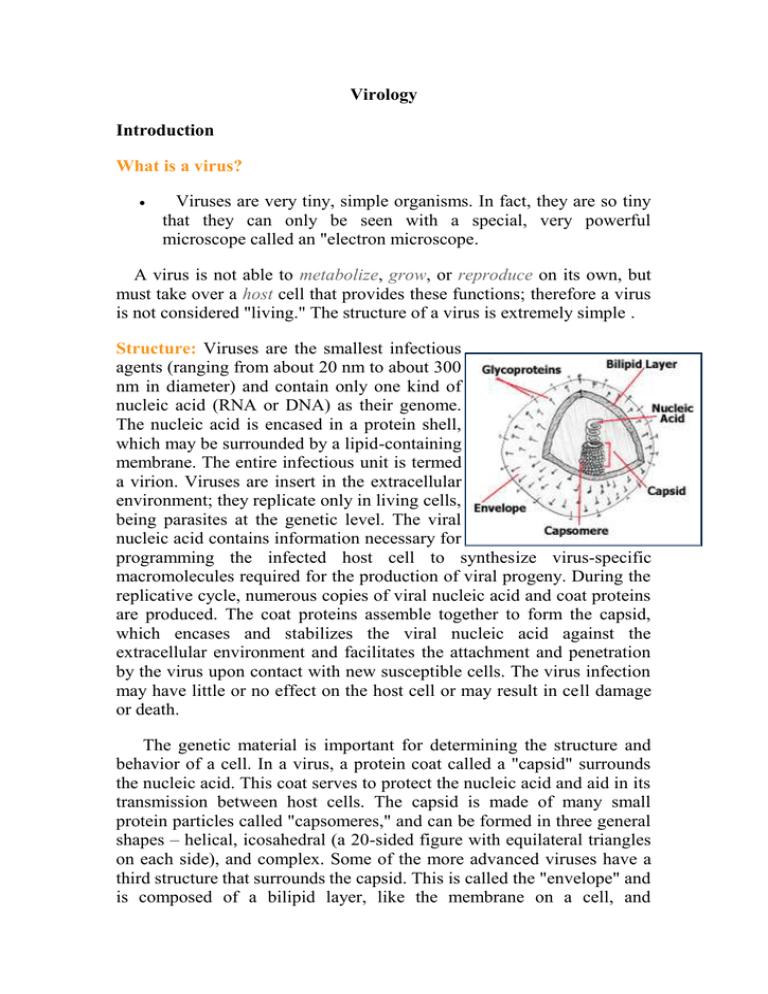
Virology Introduction What is a virus? Viruses are very tiny, simple organisms. In fact, they are so tiny that they can only be seen with a special, very powerful microscope called an "electron microscope. A virus is not able to metabolize, grow, or reproduce on its own, but must take over a host cell that provides these functions; therefore a virus is not considered "living." The structure of a virus is extremely simple . Structure: Viruses are the smallest infectious agents (ranging from about 20 nm to about 300 nm in diameter) and contain only one kind of nucleic acid (RNA or DNA) as their genome. The nucleic acid is encased in a protein shell, which may be surrounded by a lipid-containing membrane. The entire infectious unit is termed a virion. Viruses are insert in the extracellular environment; they replicate only in living cells, being parasites at the genetic level. The viral nucleic acid contains information necessary for programming the infected host cell to synthesize virus-specific macromolecules required for the production of viral progeny. During the replicative cycle, numerous copies of viral nucleic acid and coat proteins are produced. The coat proteins assemble together to form the capsid, which encases and stabilizes the viral nucleic acid against the extracellular environment and facilitates the attachment and penetration by the virus upon contact with new susceptible cells. The virus infection may have little or no effect on the host cell or may result in cell damage or death. The genetic material is important for determining the structure and behavior of a cell. In a virus, a protein coat called a "capsid" surrounds the nucleic acid. This coat serves to protect the nucleic acid and aid in its transmission between host cells. The capsid is made of many small protein particles called "capsomeres," and can be formed in three general shapes – helical, icosahedral (a 20-sided figure with equilateral triangles on each side), and complex. Some of the more advanced viruses have a third structure that surrounds the capsid. This is called the "envelope" and is composed of a bilipid layer, like the membrane on a cell, and glycoproteins, which are protein and carbohydrate compounds. The envelope serves to disguise the virus to look like a 'real' cell, protecting it from appearing as a foreign substance to the immune system of the host. The structure of a virus is closely related to its mode of reproduction. Viral Shapes Name Basic Shape Example (electron micrograph) Helical Tobacco mosaic virus Icosahedral Herpes simplex Complex T-4 Bacteriophage What are bacteria? Bacteria are very different from viruses. First of all, bacteria are much larger in size. The largest virus is only as big as the very smallest bacterium (singular for bacteria). But bacteria are still microscopic and cannot be seen with the naked eye. They are so small that the sizes of bacteria are measured in micrometers (10,000 micrometers = 1 centimeter). By comparison, the head of a pin is about 1000 micrometers wide. Though more complex than a virus, the structure of a bacterium is still relatively simple. Structure: Most bacteria have an outer, rigid cell wall. This provides shape and support. Lining the inside of the cell wall is a plasma membrane. This is like the membrane found around all living cells that provides both a boundary for the contents of the cell and a barrier to substances entering and leaving. The content inside the cell is called "cytoplasm." Suspended in the cytoplasm are ribosomes (for protein synthesis), the nucleoid (concentrated genetic material), and plasmids (small, circular pieces of DNA, some of which carry genes that control resistance to various drugs). All living cells have ribosomes, but those of bacteria are smaller than those found in any other cell. Some antibacterial medicines have been made that attack the ribosomes of a bacterium, leaving it unable to produce proteins, and therefore killing it. Because the ribosomes are different, the cells of the host are left unharmed by the antibiotic. Other antibiotics target certain portions of the cell wall. Some bacteria have long, whip-like structures called "flagella" that they use for movement. Bacteria can occur in three basic shapes: Coccus (spheres) Bacillus (rods) Spirillum (spirals) Bacterial Shapes Name Basic Shape Example (electron micrograph) Coccus (sphere) Staphylococcus aureus Bacillus (rod) (starting to divide) Salmonella typhi Spirillum (spiral) Campylobacter jejuni Reproduction: Bacteria undergo a type of asexual reproduction known as "binary fission." This simply means they divide in two, and each new bacterium is a clone of the original – they each contain a copy of the same DNA. Bacteria can reproduce very quickly. What is a fungus? Fungi (plural for fungus) are different from both viruses and bacteria in many ways. They are larger, plant-like organisms that lack chlorophyll (the substance that makes plants green and converts sunlight into energy). Since fungi do not have chlorophyll to make food, they have to absorb food from whatever they are growing on. Fungi can be very helpful – brewing beer, making bread rise, decomposing trash , most people think of fungi they picture the mushrooms that we eat. but they can also be harmful if they steal nutrients from another living organism. Structure: The main identifying characteristic of fungi is the makeup of their cell walls. Many contain a nitrogenous substance known as "chitin," which is not found in the cell walls of plants, but can be found in the outer shells of some crabs and mollusks. Most fungi are multicellular (made up of many cells), with the exception of the yeasts. The cells make up a network of branching tubes known as "hyphae," and a mass of hyphae is called a "mycelium." The insides of the cells look a little different than bacterial cells. First of all, the genetic material is gathered together and enclosed by a membrane in what is called the "nucleus." Also, there are other structures called "organelles" in the cell that help the cell to function, such as mitochondria (converts energy), endoplasmic reticulum (ER) (makes complex proteins), and other organelles. The Golgi apparatus forms many types of proteins and enzymes. Lysosomes contain enzymes and help digest nutrients. Centrioles are necessary for proper division of the cell. Both bacteria and fungi have ribosomes, but those of the bacteria are smaller in size. Reproduction: Fungi can reproduce in multiple ways depending upon the type of fungus and the environmental conditions: Budding Fragmentation Production of spores asexually Production of spores sexually Budding occurs in yeasts, which are only made up of one cell. Budding is somewhat similar to binary fission in bacteria, in that the single cell divides into two separate cells. Fragmentation is a mode of reproduction used by those fungi that form hyphae. During fragmentation, some of the hyphae break off and simply start growing as new individuals. Spores are tiny single cells that are produced by fungi that have hyphae. They can be produced asexually by a process in which the tips of the hyphae form specially encased cells – the spores. Some fungi also produce spores sexually. Two types of special cells called "gametes" are produced. One of each type unite to produce a new individual spore. Spores are tiny single cells that are usually very resistant to environmental changes. They can remain dormant for long periods of time until the conditions are right for them to develop into mature individuals.


